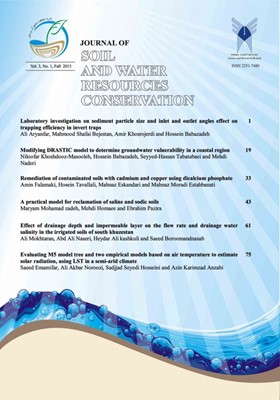Effect of drainage depth and impermeable layer on the flow rate and drainage water salinity in the irrigated soils of south khuzestan
Subject Areas : Farm water management with the aim of improving irrigation management indicatorsAli Mokhtaran 1 * , Abd Ali Naseri 2 , Heydar Ali kashkuli 3 , Saeed Boroomandnasab 4
1 - PhD student, Faculty of Water Sciences Engineering, Shahid Chamran University of Ahvaz, Ahvaz, Iran, Corresponding
2 - Professor, Department of Irrigation and Drainage, Faculty of Water Sciences Engineering, Shahid Chamran University of Ahvaz, Ahvaz, Iran
3 - Professor, Department of Irrigation and Drainage, Faculty of Water Sciences Engineering, Shahid Chamran University of Ahvaz, Ahvaz, Iran
4 - Professor, Department of Irrigation and Drainage, Faculty of Water Sciences Engineering, Shahid Chamran University of Ahvaz, Ahvaz, Iran
Keywords: drain insertion depth, drain water flow rate, impermeable layer, Salinity,
Abstract :
A new approach in drainage design call for the control of shallow water table at vicinity of the crop rootzone for the purpose of proper soil and water conservation. The objective of this study was to evaluate the effect of reducing drainage depth on salinity and water rate of drains. For this purpose, R 9-11 farm with average drainage depth of 2 and distance of 60 meters and a R 8-7 farm with depth of 1.4 and distance of 40 meters of sugarcane in south Khuzestan were selected. During the study, constructing six pisometers groups in two farms with different distances from drain collector, the daily water table level and outlet drain flow rate and the salinity of groundwater, and outlet drain in each irrigation were measured respectively. Results indicated that by increasing the irrigation water, the difference of hydraulic load between the bottom layers to the top ones in both farms, leads the vertical flow upwards. In addition, by reducing the drain insertion depth, the groundwater rate of salinity reduces, but these changes of salinity depend on the impermeable layer depth. In addition, by reducing that drain salinity was affected by irrigation water and groundwater salinity and the difference of drain insertion depths, location of impermeable layer and sand lenses affect this salinity. In addition, by reducing the drain insertion depth, outlet drain flow rate was intensively reduced such that in R 9-11 and R 8-7 farms, outlet drain reached to 3.86 and 0.74 L/s, respectively.

